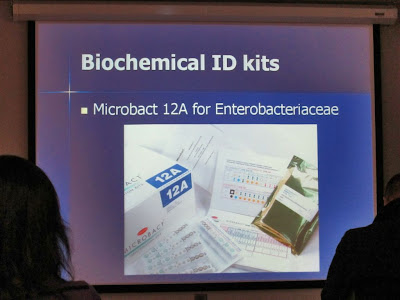Session 9
Technical supplies, proprietary methods and confirmatory test
Dr. Susan Passmore discussed the technical supplies (including Proprietary Methods and Kits) based on ISO 17025 requirements below.
· 4.6.2 – Critical consumables
· 5.4.5 – Validation of modifications to methods
· 5.4.5 – Validation of non-standard methods

Relevant ISO and other documents were briefed such as ISO 16140:2003, ISO 7218:2007 (Section 12) and EA-4/10 (Sections 4 and 7).
Then Dr. Susan Passmore introduced the metabolic properties of confirmation kits included “Biochemical Identification Techniques”, “Chromogenic agars and broths” and “Miniaturised and Diagnostic Kits”. Others included Antibody-based (ELISA, dipstick, lateral flow, Immunoconcentration) and Nucleic acid-based (Hybridisation, PCR, Riboprinting, DNA chips).
Examples of biochemical ID kits were showed.








Examples of chromogenic and proprietary media were demonstrated.




Examples of proprietary methods were discussed.








In order to use the commission method, it needed to check sensitivity and specificity from manufacturer’s validation, third part validation and certification, etc. The following was a sample certification for Aerobic Count Plate.

Session 10
Sample handling and preparation for microbiological examination
Dr. Susan Passmore briefed the ISO 17025 requirements related to sample handling and preparation below.
· 5.7.1 – Sampling plan and procedures
· 5.7.3 – Sampling records
· 5.8.1 – Sample handling procedures to protect sample integrity
· 5.8.2 – Sample identification system
· 5.8.3 – Sample condition on receipt
· 5.4.1 – Sample preparation procedure

Relevant ISO and other documents were briefed as follows:
· ISO 7218 (Sections 8 and 9 – food)
· ISO 6887 -1 to -6
· ISO 8199 (Section 7 – water)
· EA-4/10 (Section 9 – Sampling & Section 10 – Sample handling)
The sample handling stages were mentioned from Sampling (Lab or Customer) to Transportation to Receipt at Lab to Storage before Testing to Retention after Testing. All stages should be discussed with the customer thoroughly during contract review.
Session 11
Traceability requirements for microbiology laboratories
Dr. Susan Passmore briefed the ISO 17025 traceability requirements related to Equipment below:
· 5.5.2 – Capable of achieving the accuracy required
· 5.5.2 – Calibration programmes for key quantities or values
· 5.5.2 – Commissioned before use
· 5.5.5 – Equipment records
· 5.5.6 – Procedures for use
· 5.5.8 – Calibrations status labels
· 5.5.10 – Intermediate checks procedure
To Reference Materials belows:
· 5.6.6.2 – Calibration to SI units for test equipment unless it contributes little to Measurement of Uncertainty of test results
· 5.6.6.2 – Where traceability to SI units not possible, other measures should be demonstrated
· 5.6.3 – Reference standards and materials
· 5.6.3.4 – Safe handling, transport and storage

Relevant ISO and other documents were briefed as follows:
· ISO 7218 Sections 5 (all equipment) and 15.2 (cultures)
· ISO 8199 refers to ISO 7218
· EA-4/10 (Section 6) and Appendix D, E, and F (equipment); and EA-4/10 (Section 8) and Appendix C (cultures)
There were two important points for reference culture traceability.
1) Sub-culture reference stocks only once
2) The max. number of generations from culture collection was 4.
The following diagram showed the traceability of reference culture.

The details stated in EA-4/10 (Section 8) and Appendix C (cultures).

Session 12
Measurement uncertainty for microbiology testing
The last session was related to measurement uncertainty (MU) and its related ISO 17025 requirement was in clause 5.4.6.2.
The current ISO standards for MU were discussed such as ISO TS 19036:2006 (Guidelines for the estimation of measurement uncertainty for quantitative determinations) and BS 8496:2007 (Guidance on the estimation of variation of results with particular reference to the contribution of uncertainty of measurement).
The following showed examples of uncertainty components (Red color means difficult).


The uncertainties of Most Probable Number (MPN) techniques were discussed.


The uncertainties of Membrane Filtration techniques were discussed.

Finally, the worked example was demonstrated.

The following showed examples of uncertainty components (Red color means difficult).


The uncertainties of Most Probable Number (MPN) techniques were discussed.


The uncertainties of Membrane Filtration techniques were discussed.

Finally, the worked example was demonstrated.

Reference
Session 12
QUAM:2000 EURACHEM/CITAC Guide Quantifying Uncertainty in Analytical Measurement, 2nd edition – http://www.eurachem.ul.pt/guides/quam.html
Session 12
QUAM:2000 EURACHEM/CITAC Guide Quantifying Uncertainty in Analytical Measurement, 2nd edition – http://www.eurachem.ul.pt/guides/quam.html

沒有留言:
發佈留言